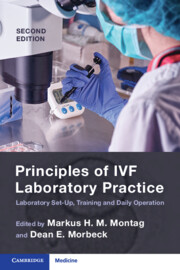Book contents
- Principles of IVF Laboratory Practice
- Principles of IVF Laboratory Practice
- Copyright page
- Contents
- Contributors
- Foreword
- The Evolution of IVF Practice
- Section 1 Starting a New Laboratory and Training Protocols
- Section 2 Pre-procedure Protocols
- Section 3 Gametes
- Section 4 Insemination/ICSI
- Section 5 Fertilization Assessment
- Section 6 Embryo Assessment: Morphology and Beyond
- Section 7 Embryo Cryopreservation
- Section 8 Embryo Transfer
- Section 9 Quality Management
- Chapter 40 Verification of Specimen Identity by Double Checking with a Witness
- Chapter 41 Quality Management in the IVF Laboratory
- Chapter 42 Troubleshooting in the IVF Laboratory
- Chapter 43 Disaster Preparedness in the IVF Laboratory
- Index
- References
Chapter 43 - Disaster Preparedness in the IVF Laboratory
from Section 9 - Quality Management
Published online by Cambridge University Press: 07 August 2023
- Principles of IVF Laboratory Practice
- Principles of IVF Laboratory Practice
- Copyright page
- Contents
- Contributors
- Foreword
- The Evolution of IVF Practice
- Section 1 Starting a New Laboratory and Training Protocols
- Section 2 Pre-procedure Protocols
- Section 3 Gametes
- Section 4 Insemination/ICSI
- Section 5 Fertilization Assessment
- Section 6 Embryo Assessment: Morphology and Beyond
- Section 7 Embryo Cryopreservation
- Section 8 Embryo Transfer
- Section 9 Quality Management
- Chapter 40 Verification of Specimen Identity by Double Checking with a Witness
- Chapter 41 Quality Management in the IVF Laboratory
- Chapter 42 Troubleshooting in the IVF Laboratory
- Chapter 43 Disaster Preparedness in the IVF Laboratory
- Index
- References
Summary
Emergency events affect assisted reproductive technology (ART) facilities around the world. Examples of natural disasters that are prone to occur in the program’s location include hurricanes in coastal areas, earthquakes, snowstorms, tornadoes, etc. Other emergencies that can occur anywhere are fires, flooding, power outages, terrorist attacks, viral pandemics, etc. During an emergency or a natural disaster, IVF programs could experience communication interruptions (e.g., phone, fax, cell phone, email, etc.), and patients and staff may be forced to evacuate to other cities or states and remain there for extended periods of time. According to the American Society for Reproductive Medicine (ASRM), each IVF program should develop and implement its own preparedness plans, which include providing for (1) protection of laboratory staff and patients, (2) preservation of cryopreserved gametes and embryos and (3) safeguarding and securing important patient data, financial and operational documents, laboratory equipment, etc. The plan should be tested and distributed among the staff to familiarize themselves with the potential disasters that could occur and receive emergency preparedness training tailored to their job responsibilities.
- Type
- Chapter
- Information
- Principles of IVF Laboratory PracticeLaboratory Set-Up, Training and Daily Operation, pp. 324 - 334Publisher: Cambridge University PressPrint publication year: 2023

